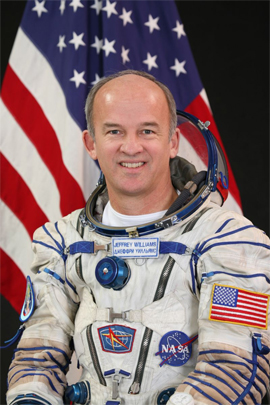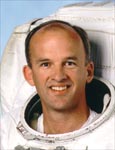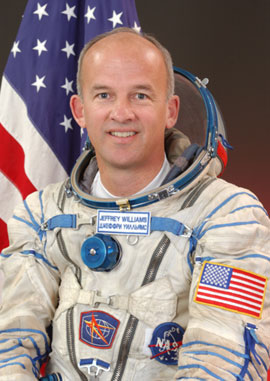RSC
Energia bio
(Sep 09) |
 Jeffrey
Nels WILLIAMS Jeffrey
Nels WILLIAMS
ISS-21 Flight Engineer,
ISS-22 Commander,
Soyuz TMA TSC Flight Engineer,
US AF Colonel,
NASA Astronaut,
Lyndon B. Johnson Space Center, USA
DATE AND PLACE OF BIRTH:
Born, January 18, 1958 in Superior, Wisconsin, USA, but considers Winter,
Wisconsin, to be his hometown.
EDUCATION:
Graduated from High School in Winter, Wisconsin in 1976.
In May 1980 he graduated from U.S. Military Academy and received a
bachelor of science degree in applied science and engineering and a rank
of a second lientenant.
In 1987 he graduated from the U.S. Naval Postgraduate School and received
a Master of science degree in aeronautical engineering and the degree of
aeronautical engineer.
In 1995-1996 he was educated by exchange at the U.S. Naval War College,
Command and Staff course and received a Master of arts degree in National
security and strategic studies.
FAMILY STATUS: Married to Anna-Marie Moore and has two children.
ORGANIZATIONS:
Association of the U.S. Army, Society of Experimental Test Pilots,
American Helicopter Society, Army Aviation Association of America,
Order of Daedalians.
AWARDS AND RANKS:
Two Meritorious Service Medals, the Army Commendation Medal, the Defense
Superior Service Medal, NASA Exceptional Service Medal, NASA Distinguished
Service Medal and two NASA Space Flight Medals (2000, 2007).
HOBBY:
Enjoys running, fishing, camping, skiing, scuba diving and wood-working.
As a cadet at the U.S. Military Academy competed in the sport parachute
team and held ratings of sport parachute jumpmaster and instructor.
WORK EXPERIENCE:
In September 1981 be was designated an Army aviator. He then completed
a three-year assignment in Germany where be served as an Aeroscout Platoon
Leader and Operations Officer in the 3rd Armored Division’s aviation battalion.
Upon graduation from the Postgraduate School in 1987 he was sent to Johnson
Space Center, where he served for over 4 years. He served as a Shuttle
launch and landing operations engineer, a pilot in the Shuttle Avionics
Integration Laboratory (SAIL) and chief of the Operations Development Office,
Flight Crew Operations Directorate.
In 1992-1993 he studied at the Naval Test Pilot School and was the
best among those who graduated from this School (103rd graduation). Since
June 1993, he served as an experimental test pilot and then Flight Test
Division Chief in the Army’s Airworthiness Qualification Test Directorate
at Edwards Air Force Base, California. He has logged over 2200 hours in
more than 50 different aircrafts.
In May 1996 be was selected for the NASA astronaut detachment (16-th
selection). In August 1996 Williams again returned to Johnson Space Center
and passed a two-year course of general space training, which be finished
in 1998 as a mission specialist. After this he was appointed to the Spacecraft
Systems Division and then – to the ISS Operations Division.
On November 16, 1998 he was selected for STS-101 crew.
From May 19-29, 2000 he performed the First Space Flight as the Atlantis
mission specialist under STS-101 Program. The main flight task was operations
onboard the International Space Station. In flight he performed one EVA
of the duration of 6 hours, 44 minutes. The flight duration was 9 days,
20 hours, 9 minutes, 8 seconds.
He passed training for a space mission within the ISS-12 back-up crew
as commander.
He performed the second spaceflight from March 30 to September 29,
2006 as the Soyuz TMA-8 spacecraft flight engineer and the ISS prime crew-13
together with Pavel Vinogradov and Marcos Pontes (spaceflight participant).
The docking to the ISS occurred on April 1, 2006. From July 6, 2006
together with Pavel Vinogradov and Jeffrey Williams as flight engineer-2
of Expedition-13 Thomas Reiter worked who was carried to the Station by
the Discovery shuttle (STS-121). On September 29 at 01:50 Moscow time the
Soyuz TMA-8 spacecraft undocked from the international Space Station. The
spacecraft landing occurred on September 29, 2006 at 05:13 Moscow time
on the Kazakhstan territory north to Arkalyk.
In flight he performed two EVAs of the total duration of 12 hours 25
min.
The flight duration was 182 days 22 hours 43 min 17 s.
In July 2008 it was reported that he was assigned instead of Shannon
Walker to the backup crew of Expedition-19 to the ISS. He passed training
under the program for Expedition-19 to the ISS as the ISS commander, the
backup crew Soyuz TMA flight engineer.
In August 2007 he was preliminarily assigned to the prime crew of Expedition-21
to the ISS. On September 21, 2008 his appointment was confirmed in the
plan of flights to the ISS, which was published by Roscosmos press-service.
On November 21, 2008 his appointment was officially confirmed by NASA when
announcing the ISS-20 - ISS-26 crew members.
September 2009
Based on data of Lyndon B. Johnson Space Center, NASA, USA, site www.astronaut.ru. |
|



 Jeffrey
Nels WILLIAMS
Jeffrey
Nels WILLIAMS
 Jeffrey
Nels WILLIAMS
Jeffrey
Nels WILLIAMS
 Jeffrey
Nels WILLIAMS
Jeffrey
Nels WILLIAMS
 Jeffrey
Nels WILLIAMS
Jeffrey
Nels WILLIAMS